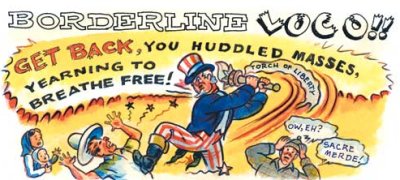« Cómo seguir vivo en Irak | Main | Olmert recibe el tiro de gracia »
Mayo 01, 2007
La vida en la frontera

Un cómic, un ensayo fotográfico de Reynaldo Leal y un gran reportaje en The Virginian Quarterly Review sobre la inmigración mexicana en EEUU. Un clásico del periodismo norteamericano, Philip Caputo, escribe sobre una frontera que conoce muy bien: Life on the Line: The Arizona-Mexico Border.
La corriente migratoria desde México hacia el norte es un fenómeno social y económico que tiene más de un siglo de vida. El Tratado de Libre Comercio en vigor desde 1994, conocido por sus siglas en inglés NAFTA, ha acelerado esa tendencia, como explica Caputo:
When the North American Free Trade Agreement (NAFTA) eliminated tariffs on the importation of American farm products, Mexico’s small farmers were devastated. They couldn’t compete with US agribusiness and lost access to markets. During the 1990s, Mexican farm income fell more than 4 percent. Young men and women left to look for work, some finding it in foreign-owned border factories—maquiladoras—but most crossed the border for higher-paying jobs. As the century and the millennium turned, even foreign factories began to shut down and move to China, where labor was even cheaper, annihilating Mexico’s traditional industries—textiles and shoes, for example. Between 2001 and 2004, 142 of the 450 maquiladoras in Juárez closed up shop, at a loss of about 100,000 jobs. The unemployed masses headed for el Norte.According to the Pew Hispanic Center, an estimated 4.5 million illegal immigrants were living in the US in 1994, the year NAFTA went into effect. By the turn of the century, the population had grown to 8.4 million. Migration slowed dramatically after 9/11, but began to rise again in 2003. Today, Pew calculates that approximately 10.3 million undocumented aliens are living here, and that’s conservative. I’ve seen estimates ranging from 12 to 18 million. (...)
Whatever its effects on Mexico, NAFTA was a win-win for US business and agricultural interests—in one direction, they got tariff-free access to Mexican markets, and, in the other direction, the commodity that capital always seeks—a large, docile, inexpensive workforce. Jobs that once paid well above minimum wage to native-born Americans—in the meat-packing industry, for example—now pay half to two-thirds what they used to. Five dollars an hour looks very good to a man or woman who was earning five dollars a day, and he or she is unlikely going to start a union, or agitate for a fatter paycheck and better benefits.
Posted by Iñigo at Mayo 1, 2007 02:15 PM
Trackback Pings
TrackBack URL for this entry:
http://www.escolar.net/cgibin/MT/mt-tb.cgi/8962